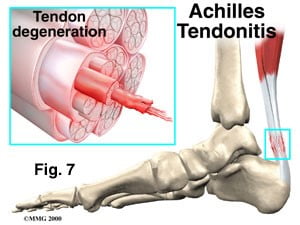Painful foot and ankle conditions arising from an injured Achilles tendon is a common condition that is commonly seen by podiatrists
Achilles tendonitis is commonly seen in our practice and can be difficult to treat. The Achilles tendon is a large structure running between the heel of your foot and the calf muscles. This tendon has several functions including operating as a shock absorber, foot stabiliser, and for active propulsion in activities such as walking and running. If you overload your Achilles tendon it can lead to the tendon becoming inflamed or even small tears developing over time.

Common Conditions – Achilles Tendonitis
Achilles tendonitis is the result of excessive stress placed on the Achilles tendon and its attachment at your heel. The most common area of irritation is about 4-5 cm above the heel. This stress is usually attributable to over use of the muscle tendon unit as it attempts to stabilise and then propel you forwards. As the muscle receives better blood supply and is better at adaptation than the tendon, it is the tendon that generally affected
The most common causes of Achilles tendonitis is a sudden increase in activity coupled with poor flexibility and poor foot posture. Other contributing factors include excessive weight, poor footwear, poor lower limb mechanics and changes in running/playing surfaces.
The primary symptom patients identify is pain along the tendon itself with examination. Pain can also be experienced with the tendon at its attachment. Clinically pain is experienced upon awakening and taking your first steps or walking after a period of rest.It will generally be tender to touch and is exacerbated with up/downhill walking
In order to successfully treat/manage Achilles tendonitis/tendonosis, it is important to address the causative factors rather than tackle the symptoms.
We have the latest technology when it comes to gait analysis and biomechanical treatment tools to assist in managing the problem efficiently. Typically your plan will involve biomechanical correction, self-management strategies, and local treatment modalities that address any strength issues. Physiotherapy treatment and rehabilitation is also generally essential to assist in management. Treatment options for Achilles tendonitis include: Corrective orthotics, sports shoe assessment and advice, stretching and strengthening exercises, anti-inflammatories, short term strapping techniques, graduated loading programmes and rest if necessary. More invasive treatment for more severe cases could also be necessary such as corticosteroid or ABI. Delaying treatment/management decreases your chances of treatment being successful. orthotics
